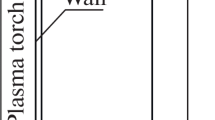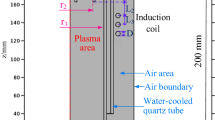Abstract
In this study, the non-equilibrium subsonic and supersonic inductively coupled plasmas (ICPs) in an ICP heater were numerically simulated and reproduced from the torch to the conical nozzle to the vacuum chamber. The flow field characteristics and the thermal non-equilibrium characteristics are obtained. Through an analysis and discussion of the plasma parameters with different nozzle throat diameters, the effects of the nozzle throat diameter on plasma properties such as the pressure, plasma velocity and temperature are obtained from the simulated results. The maximum velocity is found to appear at the exit of the nozzle, and the velocity of flow generated by a nozzle with a smaller throat diameter is found to be bigger. The pressure, velocity and temperature in the vacuum chamber fluctuate twice due to the shock wave at the nozzle’s exit. The position of the maximum temperature appears to be located in the center of the coil heating while the position of the high temperature core produced by a small diameter nozzle is closer to the inlet than that of the large diameter nozzle is. Due to the interaction between the shock wave produced by the nozzle and the plasma flow, the thermal plasma forms several independent hot heating cores in the vacuum chamber. The maximum values of the electron number density and the electric field intensity are bigger when the throat diameter of the nozzle is smaller.







Similar content being viewed by others
References
T. Fu**o, M. Yamauchi, J. Appl. Phys. 128, 173302 (2020)
T. Suzuki, K. Fujita, K. Ando et al., J. Thermophys. Heat Transf. 22, 382 (2008)
H.J. Ma, G.L. Wang, J. Luo et al., Acta Phys. Sin. 67, 025201 (2018)
L. Wang, Y. Zhao, Z. Yang et al., Ceram. Int. 47, 6397 (2020)
C. Zhao, C. Ma, Z. Wen et al., Rare Met. Mater. Eng. 48, 0446 (2019)
J. He, L. Bai, H. ** et al., Powder Technol. 302, 288 (2016)
E. Gomez, D.A. Rani, C.R. Cheeseman et al., J. Hazard. Mater. 161, 614 (2009)
B. Jim, L. Carl, P. Don et al., IEEE Trans. Plasma Sci. 39, 3187 (2011)
E. Turkoz, M. Celik, IEEE T. Plasma Sci. 42, 235 (2014)
S.B. Punjabi, N.K. Joshi, H.A. Mangalvedekar et al., Phys. Plasmas 19, 821 (2012)
D.V. Ivanov, S.G. Zverev, IEEE Trans. Plasma Sci. 45, 3125 (2017)
V. Frolov, D. Ivanov, V. Sosnin, I.O.P. Conf, IOP Ser. Mater. Sci. Eng. 643, 012071 (2019)
M. Shafaee, A. Elkaie, H. Fallah et al., Int. J. Robot. Res. 5, 133 (2016)
M. Yu, K. Yamada, K. Liu et al., AIP Adv. 9, 015120 (2019)
M. Yu, H. Kihara, K.I. Abe et al., J. Korean Phys. Soc. 66, 1833 (2015)
R.N. Gupta, J.M. Yos, R.A. Thompson et al., NASA reference publication 1232 (1990)
J.M. Yos, NASA technique memorandum RAD-TM-63-7 (1963)
C.F. Curtiss, J.O. Hirschfelder, J. Chem. Phys. 17, 550 (1949)
M. Yu, Y. Takahashi, H. Kihara et al., Plasma Sci. Technol. 17, 749 (2015)
P.Z. Chen, S.R. Sun, H.X. Wang, J. Eng. Thermophys. 36, 1067 (2015). ((in Chinese))
M. Yu, K. Yamada, Y. Takahashi et al., Phys. Plasmas. 23, 123523 (2016)
Acknowledgements
This work was supported by the National Natural Science Foundation of China (Grant no. 12175177), the China Postdoctoral Science Foundation (Grant no. 2021M693889), and the Foundation for Research and Development of Applied Technology in Beilin District of **’an (Grant no. GX2047). Computation was carried out by using the Tianhe-2 Supercomputer at the National Supercomputer Center in Guangzhou, China.
Author information
Authors and Affiliations
Corresponding author
Additional information
Publisher's Note
Springer Nature remains neutral with regard to jurisdictional claims in published maps and institutional affiliations.
Rights and permissions
About this article
Cite this article
Yu, M., Wang, Z. Effects of the nozzle throat diameter on the flow properties of an inductively coupled plasma heater. J. Korean Phys. Soc. 79, 1019–1026 (2021). https://doi.org/10.1007/s40042-021-00295-9
Received:
Revised:
Accepted:
Published:
Issue Date:
DOI: https://doi.org/10.1007/s40042-021-00295-9




